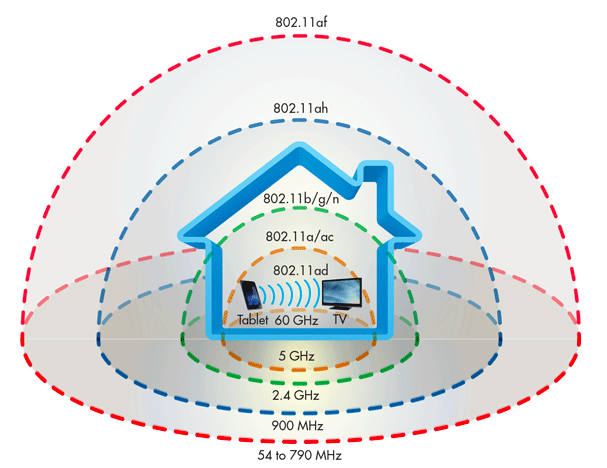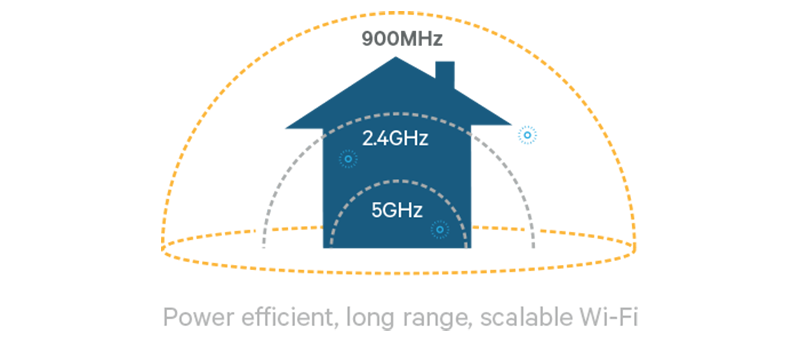
We all have been familiar with the Wifi b/g/n/ac standards, but there are new Wifi standards in town that you should know about because it’s super awesome and defines how we use the internet in the future. So, before I explain about these new standards, I want you to read about the different Wi-Fi Standard (802.11 a/b/g/n/ac) that exists now.
- Wi-Fi standard 802.11a and 802.11b, when first came in 1999, was an expensive technology.
- Wi-Fi standard 802.11g arrived in 2003 was inexpensive and 5 times faster than the previous standards, and hence replaced 802.11a and 802.11b.
- The number of users using Wireless Devices started to grow from 2003 because of its advantage over wired technology.
- All these 3 standards use the 2.4GHz frequency band.
- 2.4GHz frequency band creates interference if there are overlapping networks in the same area (like a multi-story apartment building)
- Wi-Fi 802.11n was announced in 2009 to eradicate this problem since it uses both 2.4GHz and 5GHz frequency band. The 5GHz band creates less interference.
- Wi-Fi 802.11a/c is the latest evolution of Wi-Fi, which like the 802.11n, uses both 2.4 GHz and 5 GHz spectrum.
WiFi 802.11 ad
The first new WiFi standard is 802.11 ad, which unlike other standards, uses a transmission frequency of 60GHz. This means it will have a super high speed of around 7Gb/s, however, it will have low coverage. It is only suitable for one room, and such frequency cannot penetrate the wall and the receiver should be in direct LOS (line of sight) with the router.
With a Gb/s speed, the advantage of such standard is blistering upload and download speeds meaning you can use it for transferring huge files, wireless storage, lag-free wireless docking, screen mirroring, and cordless VR glasses.
WiFi 802.11 ah
The Wifi 802.11ah is just the opposite of the WiFi 802.11 ad. Rather than focusing on the speed, it focuses on the transmission range. 802.11ah is transmitted at just 900 MHz, much similar to the GSM transmission frequency. Since the frequency is lower than that of the existing 2.4 GHz and 5 GHz WiFi technologies, 802.11ah standard can transmit up to 1km. However, the speed is not that great and it decreases with respect to distance.
Although the speed ranges from 150Kb/s to 18Mb/s, such speed is ideal for low powering devices like Internet of Things, Wireless Sensor Networks, etc.
WiFi 802.11 af
The Wifi 802.11 af, also known as Super Wifi, relies on unused television spectrum frequencies between 54 MHz and 790 MHz. Just like 802.11 ah, it can be used for low power, wide-area range, only better. It has more than 10kms of coverage making it the longest range WiFi technology yet. The Wifi 802.af can be utilized in places where there are fewer buildings and less interference.
SUMMARY – WiFi 802.11 ad Vs WiFi 802.11 ah Vs WiFi 802.11 af
- 802.11ad: for Gb/s speeds and high-performance networking.
- 802.11ah: for low data rate, long-range sensors, and controllers.
- 802.11af: for similar applications to 802.11ah. This network option relies on unused TV spectrums instead of 2.4 GHz or 5 GHz bands for transmission.

















![Best Ultrabooks To Buy in Nepal 2024 [Updated] Best Ultrabook Laptops in Nepal 2023 - June Update](https://cdn.gadgetbytenepal.com/wp-content/uploads/2023/04/Best-Ultrabook-Laptops-in-Nepal-2023-June-Update.jpg)
![Best Gaming Laptops in Nepal 2024 [Updated] Best Gaming Laptops in Nepal 2023 - June Update](https://cdn.gadgetbytenepal.com/wp-content/uploads/2023/04/Best-Gaming-Laptops-in-Nepal-2023-June-Update.jpg)


![Best Mobile Phones Under Rs. 15,000 in Nepal [Updated] Best Phones Under 15000 in Nepal 2024 Budget Smartphones Cheap Affordable](https://cdn.gadgetbytenepal.com/wp-content/uploads/2024/03/Best-Phones-Under-15000-in-Nepal-2024.jpg)
![Best Mobile Phones Under Rs. 20,000 in Nepal [Updated] Best Mobile Phones Under NPR 20000 in Nepal 2023 Updated Samsung Xiaomi Redmi POCO Realme Narzo Benco](https://cdn.gadgetbytenepal.com/wp-content/uploads/2024/01/Best-Phones-Under-20000-in-Nepal-2024.jpg)
![Best Mobile Phones Under Rs. 30,000 in Nepal [Updated]](https://cdn.gadgetbytenepal.com/wp-content/uploads/2023/12/Best-Phones-Under-30000-in-Nepal-2024.jpg)
![Best Mobile Phones Under Rs. 40,000 in Nepal [Updated] Best Phones Under 40000 in Nepal 2024 Smartphones Mobile Midrange](https://cdn.gadgetbytenepal.com/wp-content/uploads/2024/02/Best-Phones-Under-40000-in-Nepal-2024.jpg)
![Best Mobile Phones Under Rs. 50,000 in Nepal [Updated] Best Phones Under 50000 in Nepal 2024 Smartphones Midrange](https://cdn.gadgetbytenepal.com/wp-content/uploads/2024/02/Best-Phones-Under-50000-in-Nepal-2024.jpg)
![Best Flagship Smartphones To Buy In Nepal [Updated] Best Smartphones in Nepal 2024 Flagship Premium Samsung Apple iPhone Xiaomi OnePlus Honor](https://cdn.gadgetbytenepal.com/wp-content/uploads/2023/09/Best-Smartphones-in-Nepal-2024.jpg)